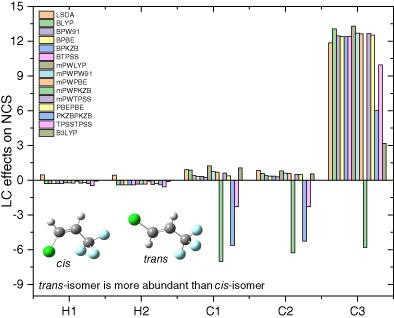当前位置:
X-MOL 学术
›
Int. J. Quantum Chem.
›
论文详情
Our official English website, www.x-mol.net, welcomes your
feedback! (Note: you will need to create a separate account there.)
Insight and performance of LC‐DFT vs DFT in the NMR shielding and chemical shift calculations: Case of CHClCH?CF3
International Journal of Quantum Chemistry ( IF 2.3 ) Pub Date : 2020-08-19 , DOI: 10.1002/qua.26408 Olivier Holtomo 1, 2 , Ousmanou Motapon 2 , Mama Nsangou 3
International Journal of Quantum Chemistry ( IF 2.3 ) Pub Date : 2020-08-19 , DOI: 10.1002/qua.26408 Olivier Holtomo 1, 2 , Ousmanou Motapon 2 , Mama Nsangou 3
Affiliation

|
Fifteen density functional theory (DFT) methods and fifteen long‐range corrected density functional theory (LC‐DFT) methods were used in the present work to assess nuclear magnetic resonance parameters such as nuclear shielding constant (NSC), nuclear chemical shift (NCS), and nuclear anisotropic shielding constant (NAS). These different methods were associated with the full basis set 6‐311++G(3df,3pd). The gauge‐independent atomic orbital was used for the calculation of nuclear shielding tensors of the nuclei contained in the stereoisomers cis‐ and trans‐CHClCHCF3. Thus, the effects of LC are clearly observed for heavy nuclei (13C, 19F, 35Cl). The results of NSC, NCS, and NAS from DFT are better described than LC‐DFT with regard to the KT3 method. Moreover, the results from the LC‐DFT are better described than the standard DFT with regard to CCSD(T). Based on the latter method used as the benchmark, the NSCs of nuclei are well fitted by the competitive functionals LC‐TPSSTPSS and LC‐PKZBPKZB. In the particular case of the trans‐isomer, mPWPKZB was found to be the best method. For the NCSs, the more accurate methods include the latter two LC functionals and the non‐LC functionals TPSSTPSS and mPWPKZB. The accuracy of NAS depends strongly on the nuclei. Thus, CAM‐B3LYP describes it well for 19F and LC‐PKZBPKZB for 35Cl. The rest of nuclei are well fitted by all the methods except 13C1 and 13C2, which are better reproduced by the LC‐DFT except the LC‐PKZBPKZB, LC‐TPSSTPSS, and CAM‐B3LYP functionals.
中文翻译:

LC‐DFT与DFT在NMR屏蔽和化学位移计算中的洞察力和性能:CHClCH的情况?CF3
在当前工作中,使用了十五种密度泛函理论(DFT)方法和十五种远程校正密度泛函理论(LC‐DFT)方法来评估核磁共振参数,例如核屏蔽常数(NSC),核化学位移(NCS) ,以及核各向异性屏蔽常数(NAS)。这些不同的方法与完整的基础集6-311 ++ G(3df,3pd)相关联。该指数无关的原子被用于包含在所述立体异构体的核的核屏蔽张量的计算轨道顺-和反式-CHClCHCF 3。因此,对于重核(13 C,19 F,35Cl)。关于KT3方法,DFT的NSC,NCS和NAS的结果比LC-DFT更好。此外,就CCSD(T)而言,LC-DFT的结果比标准DFT更好。基于后一种方法作为基准,竞争功能LC-TPSSTPSS和LC-PKZBPKZB可以很好地拟合核的NSC。在反式异构体的特殊情况下,发现mPWPKZB是最好的方法。对于NCS,更准确的方法包括后两个LC功能以及非LC功能TPSSTPSS和mPWPKZB。NAS的精度在很大程度上取决于原子核。因此,CAM-B3LYP很好地描述了19 F的情况,而LC-PKZBPKZB则描述了35 Cl的情况。除了13种方法外,其余所有核都可以通过所有方法很好地拟合C 1和13 C 2,除了LC-PKZBPKZB,LC-TPSSTPSS和CAM-B3LYP功能外,LC-DFT可以更好地复制它们。
更新日期:2020-08-19
中文翻译:

LC‐DFT与DFT在NMR屏蔽和化学位移计算中的洞察力和性能:CHClCH的情况?CF3
在当前工作中,使用了十五种密度泛函理论(DFT)方法和十五种远程校正密度泛函理论(LC‐DFT)方法来评估核磁共振参数,例如核屏蔽常数(NSC),核化学位移(NCS) ,以及核各向异性屏蔽常数(NAS)。这些不同的方法与完整的基础集6-311 ++ G(3df,3pd)相关联。该指数无关的原子被用于包含在所述立体异构体的核的核屏蔽张量的计算轨道顺-和反式-CHClCHCF 3。因此,对于重核(13 C,19 F,35Cl)。关于KT3方法,DFT的NSC,NCS和NAS的结果比LC-DFT更好。此外,就CCSD(T)而言,LC-DFT的结果比标准DFT更好。基于后一种方法作为基准,竞争功能LC-TPSSTPSS和LC-PKZBPKZB可以很好地拟合核的NSC。在反式异构体的特殊情况下,发现mPWPKZB是最好的方法。对于NCS,更准确的方法包括后两个LC功能以及非LC功能TPSSTPSS和mPWPKZB。NAS的精度在很大程度上取决于原子核。因此,CAM-B3LYP很好地描述了19 F的情况,而LC-PKZBPKZB则描述了35 Cl的情况。除了13种方法外,其余所有核都可以通过所有方法很好地拟合C 1和13 C 2,除了LC-PKZBPKZB,LC-TPSSTPSS和CAM-B3LYP功能外,LC-DFT可以更好地复制它们。

















































 京公网安备 11010802027423号
京公网安备 11010802027423号